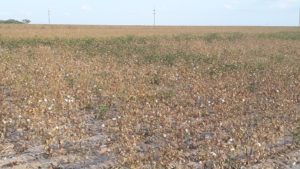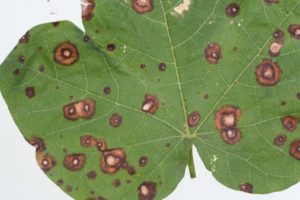Reagan Noland, Assistant Professor and Extension Agronomist
Tom Isakeit, Professor and Extension Plant Pathologist
Cotton across much of western Texas has recently displayed varying levels of premature defoliation and foliar discoloration following a drastic shift from hot and dry to abnormally cold and wet conditions in early September. The stark visual symptoms raised many questions and concerns regarding potential impacts to yield and quality, whether the situation could have been prevented, and whether intervention would have yielded any benefit. Producers and industry professionals have suspected foliar disease as the primary cause; however, a broad assessment of the situation among fields and across the region indicates the primary drivers were abiotic (weather-related) and physiological factors, rather than pathogenic.
Fields exhibiting the most severe defoliation and discoloration are generally early-planted, and/or early-maturing cotton, particularly dryland or with limited irrigation, and in drier areas within fields (Figures 1 and 2). These areas were mostly mature and heat/drought-stressed preceding the cold and wet conditions. Premature defoliation and senescence was triggered by the rapid transition from hot to cold among plants that were already both relatively mature and stressed. This response was observed simultaneously across western Texas within days following the initial temperature drop.
Fungal leafspots have also occurred in these fields. The fungi associated with the leafspots have been predominantly Alternaria and Stemphylium, usually in mixtures of species on a leaf. In general, these fungi grow readily on leaf tissue weakened by other, non-infectious stresses. So, while they may hasten the defoliation, they are not the main factor in defoliation. Non-pathogenic stresses, such as drought stress or potassium deficiency, are the predominant problem in these fields and the fungal leaf spots are secondary to this. Figure 3 illustrates a field immediately a severe instance of natural senescence. Note that the remaining green leaves are generally healthy with no foliar symptoms (prior to fungal infection).
When fungi are the main cause of defoliation, they are first seen as a few spots on lower leaves that progress in a few weeks, to become more numerous and widespread, leading to defoliation. This disease progression is driven by frequent, rainy weather and other factors such as dense foliage. During this time, there are no other foliar symptoms and, except for the leafspots, the leaves remain green (Figure 4). This was not the case in western Texas this season.
The relatively dry climate in central and western Texas does not support epidemics of foliage-infecting fungi on cotton, unlike wetter areas of the southeastern US. When environmental stresses other than pathogens lead to leaf senescence and defoliation, foliar fungicides will not have any effect on alleviating the problem, as the contribution of the foliar fungi to yield loss in the fields of western Texas is insignificant.
In the absence of other stresses, extensive leaf spots on a leaf can lead to early defoliation. This type of disease development is associated with frequent rain and yield losses can be significant. Reduction in defoliation has been possible with the timely application of fungicides. However, the application of fungicides to control fungal spots will not protect yield where the initial culprit is also a major, non-pathogenic stress, as has been seen in several cotton production areas of western Texas. In a 2020 trial in the Upper Coast growing area of Texas, which has a higher rainfall and humidity than areas to the west, fungicide applications did not result in any visible differences in the appearance of cotton foliage. In this field, the environmental stress was drought.
Overall, major negative impacts to production are not expected due to this anomaly. The most severely affected cotton was the least likely to suffer a yield reduction from premature defoliation, as most bolls had set earlier in the season, and few immature bolls lacked development. The greatest impact may be a slight reduction to lint quality in cotton with marginal irrigation that still had several immature bolls to develop. Leaf loss and reduced photosynthetic capacity due to secondary foliar pathogens may curb optimum fiber development and maturity among these late/immature bolls. However, older bolls contribute the majority of crop yield and quality. In addition to late boll development, these conditions may affect harvest aid considerations, as regrowth is common among fields with premature defoliation. Regrowth may warrant earlier-than-normal harvest aid application, and the use of different harvest aid products. Ample spray volume is also critical to ensure thorough coverage of small buds and leaves regrowing from lower nodes as well as the upper terminal.
Figure 1. Premature defoliation and senescence in West Central Texas. The green strip through the field is the backside of a terrace where greater soil moisture is generally maintained.
Figure 2. Irrigated cotton (right) showed far less defoliation and subsequent fungal symptoms than the dry corner (left) in this pivot-irrigated field (Taylor County 9/17/2020).
Figure 3. Cotton exhibiting premature defoliation prior to obvious fungal infection.
Figure 4. Fungal leafspots on an otherwise healthy cotton leaf (left) vs. secondary infection of Alternaria and compounded with symptoms of other environmental stress (right).




